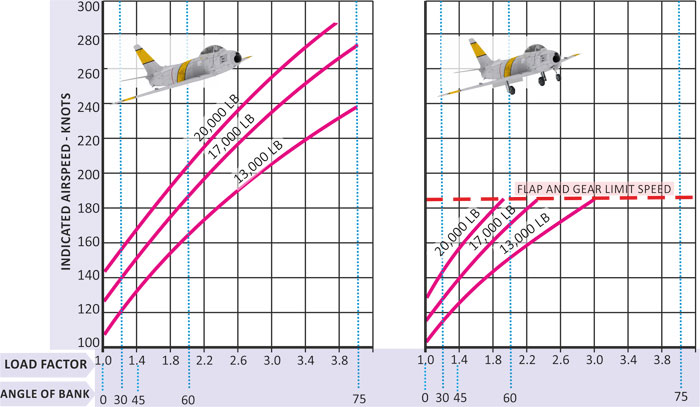The North American F-86F Sabre is a day, clear weather, transonic fighter-interceptor with a secondary ground attack capability. The foremost US fighter of the Korean War (1950-53), the F-86 was the only Allied jet that could hold its own – and in the right hands, outmatch - the Russian-made MiG-15s over the bitterly-contested North Korean airspace known as ‘MiG Alley’.
The F-86F is armed with six .50 in/12.7 mm Colt-Browning М3 machine guns, with a rate of fire of 1100 rounds per minute and 300 rounds per gun. A game-changer at the time, the Sabre’s excellent APG-30 gunsight helped give it the edge in dogfights, enabling accurate fire at longer ranges. It can also carry two AIM-9B Sidewinder missiles. For air-to-ground strikes the F-86 can deliver up to sixteen HVAR unguided rockets or pairs of AN-M64 500lb or M117 750lb General Purpose bombs.
Powered by a single General Electric J47-GE-27 turbojet providing 5,910 lbs of thrust, the F-86F has a maximum speed of 595 knots at sea level, a rate of climb of 9,000 fpm to 49,600 feet and a combat radius of about 600 nautical miles.
Almost 10,000 were built, making the F-86 the most-produced Western jet-fighter of all time. Exported to many countries, it saw service with almost 30 air forces. It last saw action flying in Pakistani Air Force colors during the 1971 war with India.
Experience the strengths and challenges of the Sabre in combat and find out why seasoned fighter pilots often look back on it as the most enjoyable aircraft they ever flew.
Stalling in level flight occurs without warning shaking (typical for the unslatted F-86) to any side with a nosing down of the aircraft. Simultaneously, roll reversal manifests itself to the control stick input. The sign of upcoming stall may be developing includes vibrations, banking while holding the aircraft horizontally, and speed drop.
During landing, it is necessary to observe the recommended speed to prevent stalling speed in various configurations.
Stalling in level flight occurs at lower speeds based on configuration. This owes to the fact that in the flight at positive angles of attack there is a vertical component of the engine thrust decreasing value of the required lift and, consequently, value of the required angle of attack.
The presence of external loads increases the stalling speed approximately by 10 knots.
At vigorous pull-up command (due to the high controllability in pitch) can induce departure mode without the warning shaking with abrupt wing drop.

Recovery from a stall is performed by a slight pushover and increase of RPM.
An aircraft enters a spin in any configuration and in all the flight speed range up to the Mach number of 0.9. In any case, the spin is the result of stall at excessing available g forces during maneuvering or at the drop of speed lower than the allowable one for the current weight and flight configuration of the aircraft.
With the correct spin recovery technique taken into account and available altitude, aircraft recovery is possible from any kind of spin.
Upon entering a spin, the aircraft nose goes below the horizon to the angle of 50-75 degrees with a slow rotation. When the rotation rate increases, the aircraft nose goes up almost to the horizon. The first spin turn occurs approximately in 5-8 sec. with the altitude loss of 500-600 feet. During the next turn, the rotation rate increases with the diminution of amplitude of nosing up to the horizon and an increase of the climb angle to the vertical one.
At the same time, with each next turn the altitude loss increases and may reach 2.000 feet per turn.
Typically, the aircraft falls into a right-hand spin.
A spin with increased engine thrust is characterized by smaller climb angles and higher rotation rate.
A spin with minimal thrust or without power is characterized by a steeper (up to 90 degrees in the process of development) trajectory.
The spin quality does not change with the speedbrakes deployed.
In landing configuration, the spin peculiarity is smaller altitude loss at first turns.
With external fuel tanks, a change of spin direction may occur both upon entering the spin and after several turns.
Spin recovery occurs when the controls are set to their neutral position. As a rule, simultaneously, the aircraft recovers from the spin on its own with some delay.
For a controlled spin recovery, it is recommended:
If an aircraft carrying external loads has entered a spin and it is impossible to recover from the spin in the course of one or one and a half turns, then it is recommended to jettison all external loads and recover the aircraft from the spin according to the normal procedure.
It is forbidden to execute the following maneuvers:








